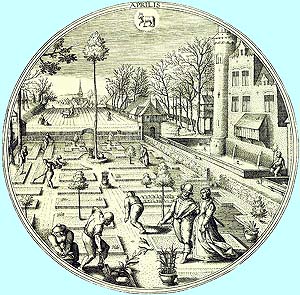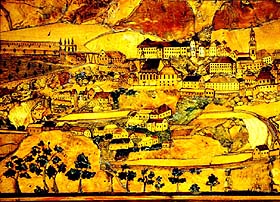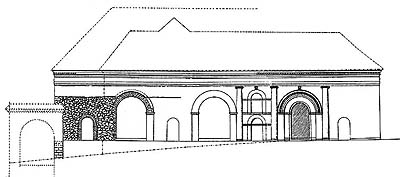The historical evolution of Český Krumlov gardens and parks in the reign of the last Rosenbergs (Renaissance and Mannerism period)
 In the middle of the 16th
century, to the south of the cloister grounds the garden and the
widow's residence of Anna of
Roggendorf at Nové Město emerged (Novoměstská
garden). The serf houses and yards with their gardens
originally situated here were bought, and on their place city
seigniorial garden gradually emerged, probably still of a medieval
character. In the middle of the 16th century, gardens and vineyards
were also situated on the south slopes under Horní hrad (the upper
castle). In the 16th century, gardens also emerged on the hills to
the west of the Český Krumlov castle, on the place of the later
castle gardens. From the middle of the 15th century, the medieval
fortification of the western field in front of the castle, so
called Plášť, demarcated an interior protected territory where
eventually seigniorial gardens emerged (see the local indications
"zahrada na Plášti", "plášťová zahrada"). Until the year 1555 the
existence of a summerhouse (lusthaus) here is substantiated with
documents. An interesting fact is that in the close vicinity of the
seigniorial gardens, as is supported by a report from the year
1554, the garden of the men's tailor Linhart Hyrš was situated. We
have relatively many reports about the existence of burgher's
gardens and farmstead gardens from the second half of the 16th
century; some difficulties are caused by their localisation, but
the main problems are due to the scarce information about their
appearance. Among the significant ones are the courtyard with
garden of the Rosenberg hejtman Jan Benýtek, the protégé of
Petr
Vok of Rosenberg. The establishment of a water main for the
residents of Plešivec was particularly due to these good relations
between the hejtman and the Rosenberg ruler, which supplied the
courtyard of Benýtek and other houses at upper Plešivec with water
from the seigniorial gardens (i.e. from today's reserve garden
centre of the castle administration). From the year 1612 we have
the report that the abbess of the Clarissian cloister bought
hop-gardens and fields in the suburbs of Budějovice from the
painter Bartoloměje
Beránka Jelínka. Besides gardens, orchards, hop-gardens and
fields, we also see production buildings: a sawmill, a mill, the
brickworks and limekiln at Plešivec, all making their mark in the
appearance of the town landscape of Český Krumlov.
In the middle of the 16th
century, to the south of the cloister grounds the garden and the
widow's residence of Anna of
Roggendorf at Nové Město emerged (Novoměstská
garden). The serf houses and yards with their gardens
originally situated here were bought, and on their place city
seigniorial garden gradually emerged, probably still of a medieval
character. In the middle of the 16th century, gardens and vineyards
were also situated on the south slopes under Horní hrad (the upper
castle). In the 16th century, gardens also emerged on the hills to
the west of the Český Krumlov castle, on the place of the later
castle gardens. From the middle of the 15th century, the medieval
fortification of the western field in front of the castle, so
called Plášť, demarcated an interior protected territory where
eventually seigniorial gardens emerged (see the local indications
"zahrada na Plášti", "plášťová zahrada"). Until the year 1555 the
existence of a summerhouse (lusthaus) here is substantiated with
documents. An interesting fact is that in the close vicinity of the
seigniorial gardens, as is supported by a report from the year
1554, the garden of the men's tailor Linhart Hyrš was situated. We
have relatively many reports about the existence of burgher's
gardens and farmstead gardens from the second half of the 16th
century; some difficulties are caused by their localisation, but
the main problems are due to the scarce information about their
appearance. Among the significant ones are the courtyard with
garden of the Rosenberg hejtman Jan Benýtek, the protégé of
Petr
Vok of Rosenberg. The establishment of a water main for the
residents of Plešivec was particularly due to these good relations
between the hejtman and the Rosenberg ruler, which supplied the
courtyard of Benýtek and other houses at upper Plešivec with water
from the seigniorial gardens (i.e. from today's reserve garden
centre of the castle administration). From the year 1612 we have
the report that the abbess of the Clarissian cloister bought
hop-gardens and fields in the suburbs of Budějovice from the
painter Bartoloměje
Beránka Jelínka. Besides gardens, orchards, hop-gardens and
fields, we also see production buildings: a sawmill, a mill, the
brickworks and limekiln at Plešivec, all making their mark in the
appearance of the town landscape of Český Krumlov.
During the rule of Wilhelm of Rosenberg, the extent of the Novoměstské gardens was expanded by further purchases. The garden (in that time named as the lower garden at Nové město (New town) was connected to the castle by a system of covered passages, therefore easily accessible for the castle gentry. The garden landscaping begins to change gradually here in the spirit of the Renaissance. Even though we do not have any reports about its compositional arrangement, it is known that the garden became the site of the scientific work of one of the leading Czech natural scientists of his time - Adam Zalužanského of Zalužan. The mentioning of an orangery, probably the second oldest of central Europe, as well as the later inventory of breeded exotic plants gives evidence of the high professional level of the horticulturists working here.
 In the year 1590, on
instruction of the Rosenbergs, three farmsteads and adjacent
grounds opposite their new college (from the years 1586 - 1588),
were bought out by the town for the Český Krumlov Jesuits, on the
left banks of the Vltava in the area where today's Town
Park is situated. Only one year later, the newly emerged Jesuit
grounds was surrounded with a wall and made accessible from the
Jesuit college by a wooden bridge over the Vltava. To the south and
west the plots of the Jesuits were delimited by the surface of the
cemetery with the chapel of St. Martin (at the time still wooden),
a poorhouse building (reg. no. 60) and further by several
homesteads near today's Linecká street. In this way, a suburbial
religious summer seat was formed, which without a doubt included
also the gardens. As if in the shadow of Wilhelm's building
activities in Český Krumlov, the period of the rule of Petr Vok of
Rosenberg stands. At the same time, however, this last Rosenberg
also expressed his interest in theological and historic literature,
collecting, and about nature and gardens. He divided his attention
harmoniously between the town and the castle residence. In
particular during his ruling in the years 1593 to 1600, a game park
and in the middle of the castle pond "the garden on the island -
zahrada na ostrově" emerged to the north of the castle (on today's
territory of th Deer
Gardens). The actual area of the proportionately small garden,
on the ground plan of a regular quadrangle (a square of the
approximate dimensions of 75 x 75 meters), was walled in by a
circumferential wall with a gallery. The above mentioned lusthauz
was obviously situated in the axis of the garden. A short
description of the garden disposal of the time offers an
interesting analogy with the present garden at Kratochvíle. The
configuration of the grounds in the case of the Český Krumlov
castle enabled a visual connection from the gardens to the north
facade of the castle, where the former palace of the last
Rosenbergs was situated in the place of the present Mirror Hall.
From there a striking view onto the garden, stretching out
underneath, unfolds. In the area of the north field in front of the
fortress (resp. castle), it is necessary to further situate the
game park, pheasantry, a cuttery for precious stones and a sawmill
for the processing of exotic timber, also mentioned in the archive
sources. Not far away, on today's 5th castle courtyard, an
extraordinarily extensive palace type construction emerged at the
same time. It was built by Domenico
Benedetto Cometta of Eckthurn. The palace (today known as the
Renaissance
house), with its north-western facade with six exceptionally
large niches, faced the slope with the seigniorial gardens above
the castle. The ambitious construction programme of Vok was
evidently a response to the foundation of the Royal Game Parks by
emperor Rudolf II and gives evidence of the cultural orientation of
the last Rosenbergs on the artistic circle of the imperial court of
Prague.
In the year 1590, on
instruction of the Rosenbergs, three farmsteads and adjacent
grounds opposite their new college (from the years 1586 - 1588),
were bought out by the town for the Český Krumlov Jesuits, on the
left banks of the Vltava in the area where today's Town
Park is situated. Only one year later, the newly emerged Jesuit
grounds was surrounded with a wall and made accessible from the
Jesuit college by a wooden bridge over the Vltava. To the south and
west the plots of the Jesuits were delimited by the surface of the
cemetery with the chapel of St. Martin (at the time still wooden),
a poorhouse building (reg. no. 60) and further by several
homesteads near today's Linecká street. In this way, a suburbial
religious summer seat was formed, which without a doubt included
also the gardens. As if in the shadow of Wilhelm's building
activities in Český Krumlov, the period of the rule of Petr Vok of
Rosenberg stands. At the same time, however, this last Rosenberg
also expressed his interest in theological and historic literature,
collecting, and about nature and gardens. He divided his attention
harmoniously between the town and the castle residence. In
particular during his ruling in the years 1593 to 1600, a game park
and in the middle of the castle pond "the garden on the island -
zahrada na ostrově" emerged to the north of the castle (on today's
territory of th Deer
Gardens). The actual area of the proportionately small garden,
on the ground plan of a regular quadrangle (a square of the
approximate dimensions of 75 x 75 meters), was walled in by a
circumferential wall with a gallery. The above mentioned lusthauz
was obviously situated in the axis of the garden. A short
description of the garden disposal of the time offers an
interesting analogy with the present garden at Kratochvíle. The
configuration of the grounds in the case of the Český Krumlov
castle enabled a visual connection from the gardens to the north
facade of the castle, where the former palace of the last
Rosenbergs was situated in the place of the present Mirror Hall.
From there a striking view onto the garden, stretching out
underneath, unfolds. In the area of the north field in front of the
fortress (resp. castle), it is necessary to further situate the
game park, pheasantry, a cuttery for precious stones and a sawmill
for the processing of exotic timber, also mentioned in the archive
sources. Not far away, on today's 5th castle courtyard, an
extraordinarily extensive palace type construction emerged at the
same time. It was built by Domenico
Benedetto Cometta of Eckthurn. The palace (today known as the
Renaissance
house), with its north-western facade with six exceptionally
large niches, faced the slope with the seigniorial gardens above
the castle. The ambitious construction programme of Vok was
evidently a response to the foundation of the Royal Game Parks by
emperor Rudolf II and gives evidence of the cultural orientation of
the last Rosenbergs on the artistic circle of the imperial court of
Prague.
The art of gardening at the end of the 16th century reached its peak in Český Krumlov with the Manneristic modifications of the Novoměstské gardens. In that time it was the most sophisticatedly arranged garden of all those owned by the Rosenbergs in Český Krumlov. The compositional division and appearance of the gardens can be well reconstructed according to the inventory from the turn of the 16th and 17th centuries, comprised when this garden together with the whole Český Krumlov demesne passed over to the property of the imperial court. Even though the "pens" in the Novoměstské garden, composed of variety of plants (i.e. a mixture of fruit trees, shrubs, medicinal plants and decorative flowers), still echoes of the medieval understanding of gardens, the garden as a whole is nonetheless conceived in the spirit of the Renaissance. From the collection of Renaissance type garden spaces, the Novoměstská garden can be most likely be indicated as a "giardino de semplici", a garden with a mixed utility and decorational character. It was most frequently divided by a rectangular system of paths into quadrangle beds, bordered with a low little fence. The beds themselves were planted with flowers and ornamental trees while the quadrangles were completed by arbours.
Further information:
- The historical evolution of Český Krumlov gardens and parks in the 14th and 15th centuries (Gothic period)
- The historical evolution of Český Krumlov gardens and parks under the administration of the emperor in the years 1601 - 1622 (Mannerism period)
- The historical evolution of Český Krumlov gardens and parks in the period of the reign of the princes of Eggenberg in the years 1622 - 1719 (Mannerism period and the beginnings of the Baroque)
- The historical evolution of Český Krumlov gardens and parks in the reign of the first two generations of the princes of Schwarzenberg in the years 1719 - 1782 (Baroque and Rococo period)
- The historical evolution of Český Krumlov gardens and parks in the years 1782 - 1850 (Classic and Romantic period)
- The historical evolution of Český Krumlov gardens and parks in the years 1850 - 1939 (Historic period and modern times)
- The historical evolution of Český Krumlov gardens and parks from the year 1939 to the present


